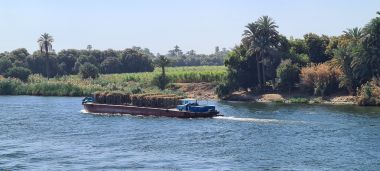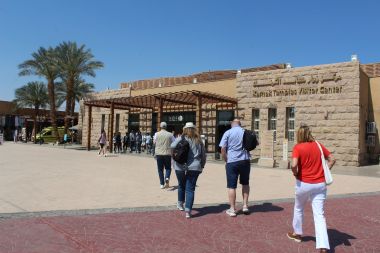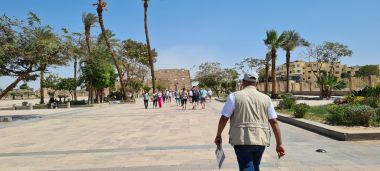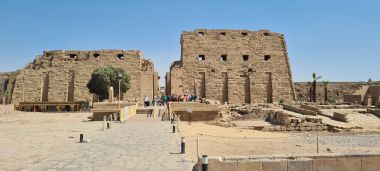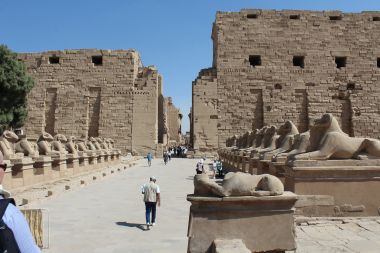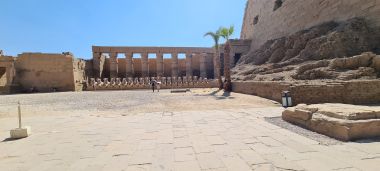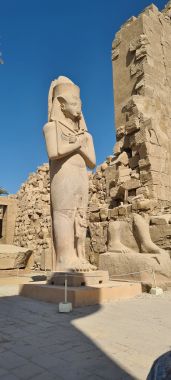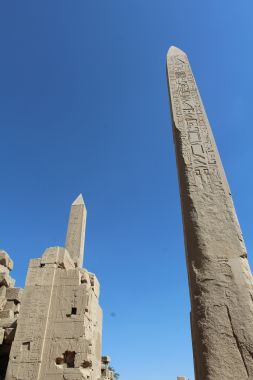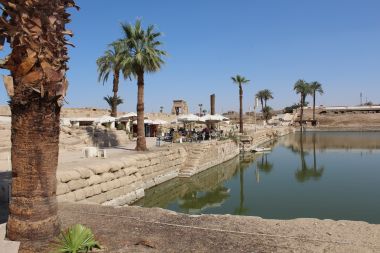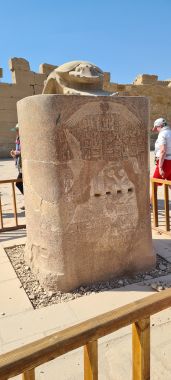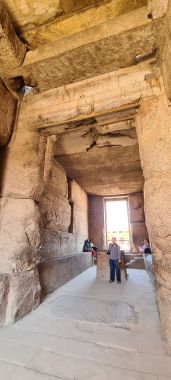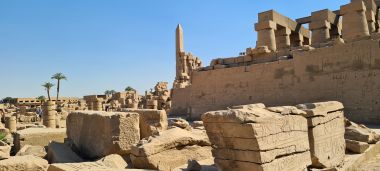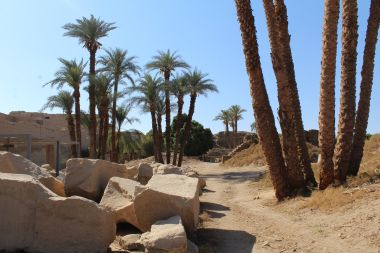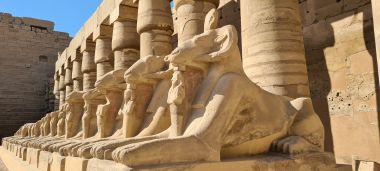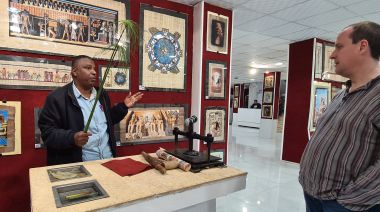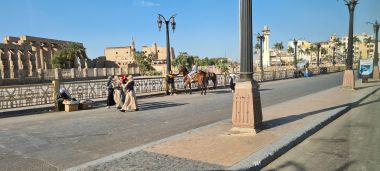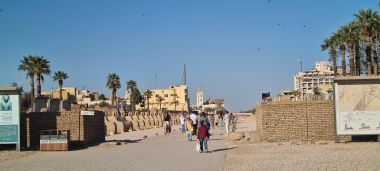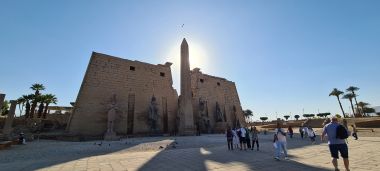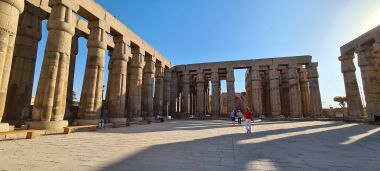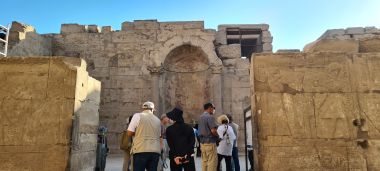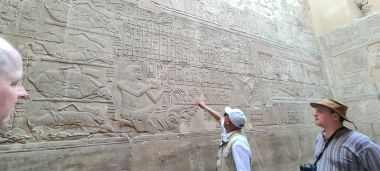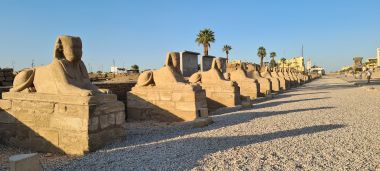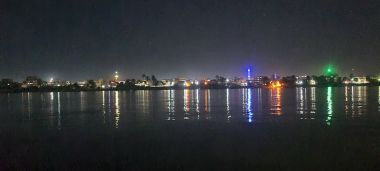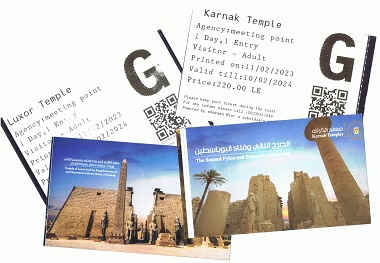Day 7 - Luxor Temples - March 15, 2023
A relaxing morning following breakfast at a respectable 8 am watching the scenery go by though it was a bit cool despite the sun so we needed to put on long sleeves. Mel had her second full body massage at 10 for an hour at the back of the boat while I did a bit of bird watching with the binoculars.
At 11:30 we met in the lobby with our fellow German passengers grabbing our packed lunches then disembarking the boat to board coaches for our trip to visit the Luxor temples. Though the boat was heading there the coaches were quicker though it was a bit of an odd feeling to be getting off the boat with all of our stuff onboard and it leaving a short time later without us. In any case this was the first time we had seen the boat from the outside having only ever embarking or disembarking when it was moored alongside some other boats, all we had ever seen before were the other boats!
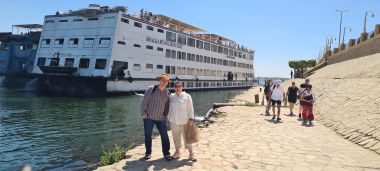
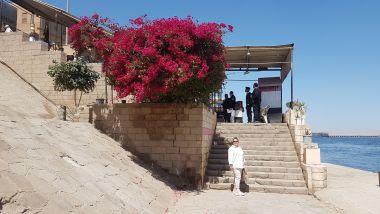
The coach took us from our mooring in Esna along the west bank of the Nile passing through several small villages. It was interesting to watch life unfold as we passed by: Children in uniform leaving school, a mechanic working on a motorcycle, woman shopping for fresh vegetables at a stall, donkeys standing under a tree eating with chickens around it's feet, trucks piled high with sugar cane, with many people giving us a friendly wave in return to ours as we passed by.
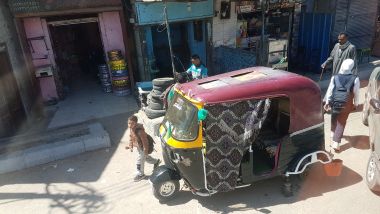
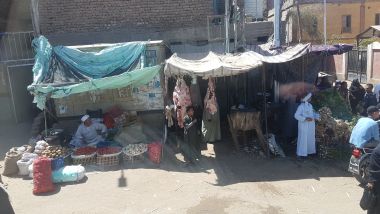
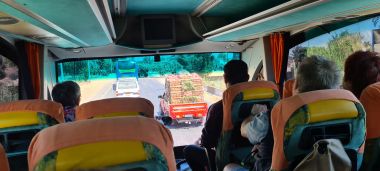
Early in our ride we tried to cross to the other side of the river but were told the road was closed so had to proceed all the way to Luxor on the west bank crossing to the east side, where Luxor is situated, only when we got to the bridge close to where we had originally boarded the boat five days ago. An hour and a half later as we approached the city the roads of course got busier and much more cosmopolitan with large concrete overpasses and many lanes.
Luxor is a big city of more than 1.3 million people but in the middle of it are two enormous temples connected by an avenue of sphinxes 1.7 miles long. For many years these temples lay under sand or, in the case of the avenue, under the streets of the city itself as people built on top of them. Now both the temples and the avenue are restored and look magnificent. Our first glimpse of all of this was when we stopped on a bridge midway along the length of the avenue to change from the large coach to a smaller van joining our chatty English speaking guide Ahmed, the same guide who had first talked to us on the boat about our tour options on our first day of cruising. The avenue stretched quite some direction to either side of us with the amazing buildings of temple at either end.
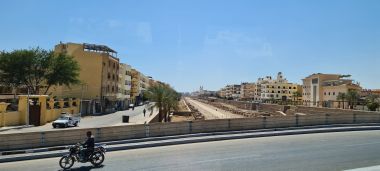
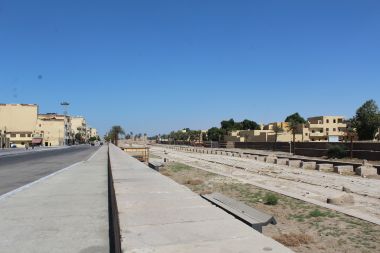
Through Amhed we learned that the Luxor temples are intentionally situated on the east bank where the sun rises as they are temples of life while on the west side over which the sun sets is where the temples of death and the afterlife, as well as the valley of the kings, are located.
Our first visit was to the Karnak Temples. I say templeS as Karnak is a temple complex inside a walled exterior with entrances on each side. As always we were dropped at the main entrance while the driver parked the vehicle entering the modern visitor centre where a large diorama of the site dominated.
It was great to see it like this as when we were in the temple complex it was often difficult to take in the context of what we were seeing. After the normal security scanning and ticket formalities we walked quite a way down a wide paved avenue lined with palms to the west entrance of the complex. This entrance used to right on the river but now is more than 300 meters away.
As at Philea the entrance is flanked by two tall blocks though here they are undecorated and a more contemporary mosque is off to the right (near the toilets, for some reason).
Outside the entrance there is a small avenue of ram-headed sphinxes.
We were told the site had been abandoned for many years and when discovered was buried in sand more than half way up the outside walls which preserved a lot of the intricate carvings inside. Inside the gate we were in a large open courtyard with a small temple to our immediate left (Temple of Sety II) and another to the far right (Temple of Ramses III) as well as another row of ram-headed sphinxes.
The remains of an earth ramp to our immediate right hinted at how the massive stones in the structure would have been transported to the wall which was never finished. Walking further into the courtyard we were shown the only artefact here of King Tutankhamun: A small alabaster sphinx with the young king's head. To the left of this is a large statue to the one and only Ramses II.
Past the courtyard we entered a room full of tall intricately carved pillars packed close together: The Great Hypostyle Hall. While there is no longer a roof it was pointed out the centre most pillars were taller than the others so as to have two different levels of roof with open spaces between to improve ventilation and, likely, to let in more sun.
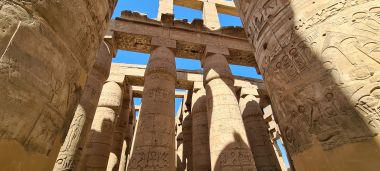
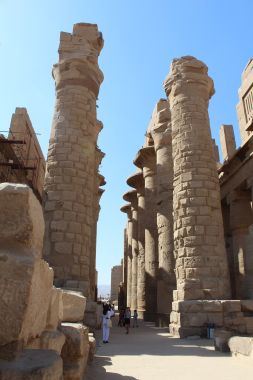
Beyond this incredible space there are the remains of a number of smaller temple buildings as well as two obelisks.
We were taken to the right with it's square “Sacred Lake” that no one appears to understand what was used for though Ahmed suggested it might just have been used for bathing but there are mysteries still with it as they have no idea how the water enters the site nor even how deep it is.
On the northern side of the lake is a small café which attracted the attention of many tourists but they were also busy walking around the large carving of a scarab beetle on a plinth. It is said that if you walk around the statue a certain number of times you will receive good luck…so we promptly did our duty.
At this point Ahmed gave us 40 minutes to wander around the site before meeting him by the main gate at 3 pm. Mel and I took the opportunity to visit the far eastern and northern reaches of the site.
There are paved paths throughout the site as we tried to take it all in which is difficult with only the barest outlines of buildings now present. There are so many big pieces of stone carving lying on the ground it is hard to put them into complex but we certainly admired the artistry.
On the north they have what they call an “open air museum” where many large pieces of archaeology lie amongst the palm trees with the northern gate in the distance.
Before meeting back up with Ahmed we had a wander around the hall of pillars to take in the sheer size and majesty of the place. The carvings in the wall are truly incredible with more of the colour we have seen elsewhere. We also had time to visit the Temple of Ramses III, it's walls lined with colossi of the pharaoh.
Karnak Temple Pictures (from Flickr)
A quick drink the van and we were down some side streets beside the temple where we stopped at the “New Karnak Papyrus Institute” which had a large number of papyrus artwork on show. We were first shown how the papyrus paper was made as we had a free drink of hibiscus water. The papyrus plant has a long stalk with a a sprout at the end which is split into thin strips that are then soaked in water to make them pliable. The strips are then rolled flat and placed alongside on another then a second layer placed at 90 degrees on top (not woven which would make the paper too uneven). The paper is then placed into a press for a long time to dry before it can be used. Of course the main reason we were here is to sell us some of their art but I was not all that keen but eventually we settled on a scene I recognised from a chair found in King Tutankhamun's tomb of the king and his wife as well as another of the tree of life which we got for a reasonable price but declined when they offered to paint a hieroglyphic version of our names on the image of King Tut and his wife but that would be way too tacky as we wanted a pieces of art rather than a simple souvenir.
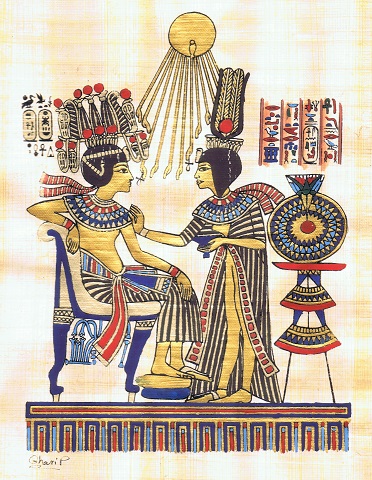
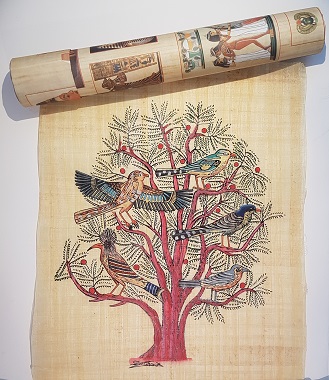
There were loads of other papyrus pictures that would appeal to some but we were not so moved such as glittery animals and other images that are probably more suitable to velvet than papyrus.
Leaving the art gallery behind we made our way along the river to our second stop of the day, the smaller Luxor Temple at the opposite end of the avenue of the sphinxes passing by many horse drawn tourist carts and the temple itself.
The temple was built in approximately 1400 BC by Amenhotep III, Tutankhamun and Ramesses II. As we approached the car park for the temple the driver had to slow down due to the large number of pigeons on the road with Ahmed eventually amusingly trotting in front of the vehicle chasing them away with his clipboard. After entering the temple site the temple was on our left and the sphinx avenue began just to our right so we were able to get up close to some of the sphinxes and appreciate the view along the avenue (in Karnak where the avenue meets the temple is currently closed to tourists).
The main entrance to the temple to the consists of two huge blocks, as always, and has two six colossi, three on either side along with a tall obelisk.
Inside the first courtyard (“Ramses II”) there is a mosque about 10 meters up on the left. This was the height the sand originally reached when the site was abandoned so a mosque was built here (Abu El-Haggag Mosque) which itself is now a protected monument and still used so when the site was being restored they had to preserve it as well. Around the courtyard there are the remains of columns with the south-east corner containing some standing colossi of Rameses II.
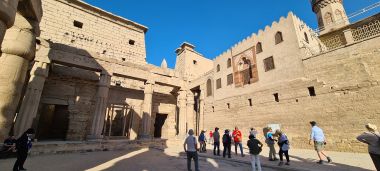
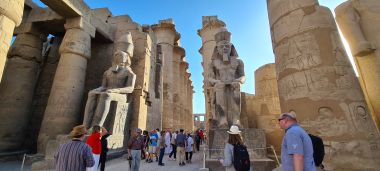
Proceeding into the temple we passed by two seated colossi then into a narrow path lined with tall pillars then into another, large, courtyard dedicated to Amenhotep III lined with papyrus pillars.
Beyond this there was a confusion of archaeology with Christian symbology painted on the walls as this was used as a Roman Christian temple and such was the contempt of the Egyptian ancients they carved rings out of the stone carvings to tie up their animals.
Despite this there were some amazingly preserved intricate carvings surrounding the roman temple including those that describe the yearly calendar of sacrifices to be made.
At this point Ahmed gave us 30 minutes to look around before meeting again outside the main entrance. We had a bit of hassle from local people who offered to show us some interesting things or have their picture taken (of course for a fee) but we avoided them and wandered around some of the sections we had not yet seen but the site is quite small and narrow. As the sun was getting close to setting long shadows were cast over everything from the tall columns. We were able to get a good close-up look at the Avenue of Sphinxes…
It had been a lot of walking in the two temples so the rest of our group were waiting for us at the main entrance as we headed back to the boat.
Luxor Temple Pictures (from Flickr)
As we travelled through Luxor we stopped at an ATM for one of our group to get money for a taxi to the airport tomorrow morning. We were disappointed to learn our hot air balloon ride over the Valley of Kings which we had booked was cancelled due to strong wind conditions. Much to our delight the boat was where we expected it to be in the rather dubious location quite close to the concrete Luxor Bridge we had crossed earlier in the day. After a brief return to our cabin we met Ahmed in the lounge to receive our refund where he asked us whether we would be interested in some extras - A light show at Karnak and a horse cart tour of Luxor. We declined on both. We also learned our Cairo flight details in two days time which will mean another early wake up. But, we still have another day yet and tomorrow we have to meet at 7 am for our trip to the Valley of the Kings meaning that breakfast is at 6 am.
After dinner we returned to the roof but it was quite cool. We are the last boat moored up so we had a clear view of the mosque minarets lit up in garish colours looking for all the world rather like amusement parks than religious buildings. In the distance on the western shore we could see to the north lights on the side of the hills - This is where the Valley of Kings is located, lit up at night.
In the room I did a bit of laundry as I am running low on underwear so it should hopefully dry on the various hangers I have around the room before we leave Luxor. I have caught a bit of sun today but hopefully it is not too serious.
⇒ Continue to Day 8 - Valley of the Kings - March 16, 2023
